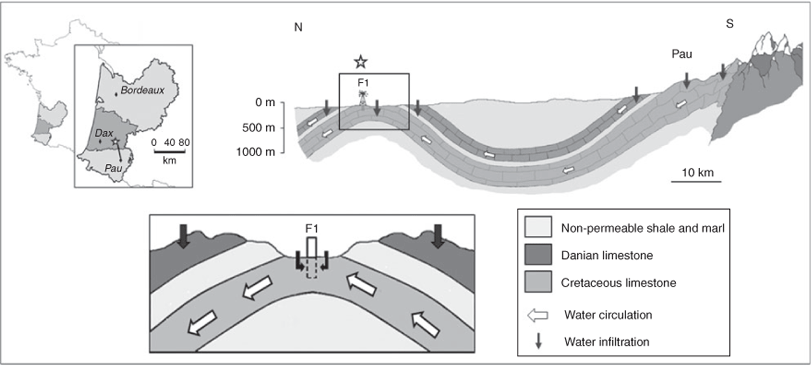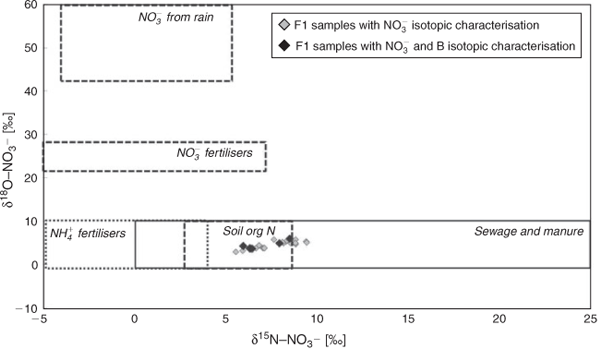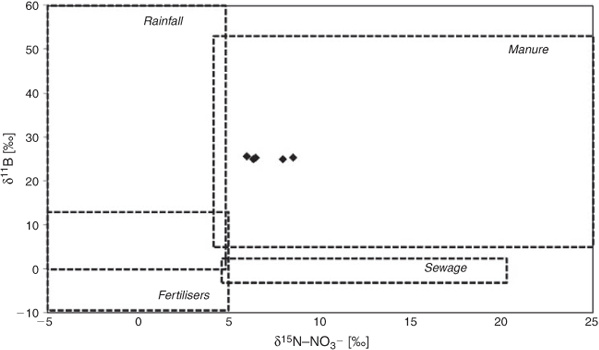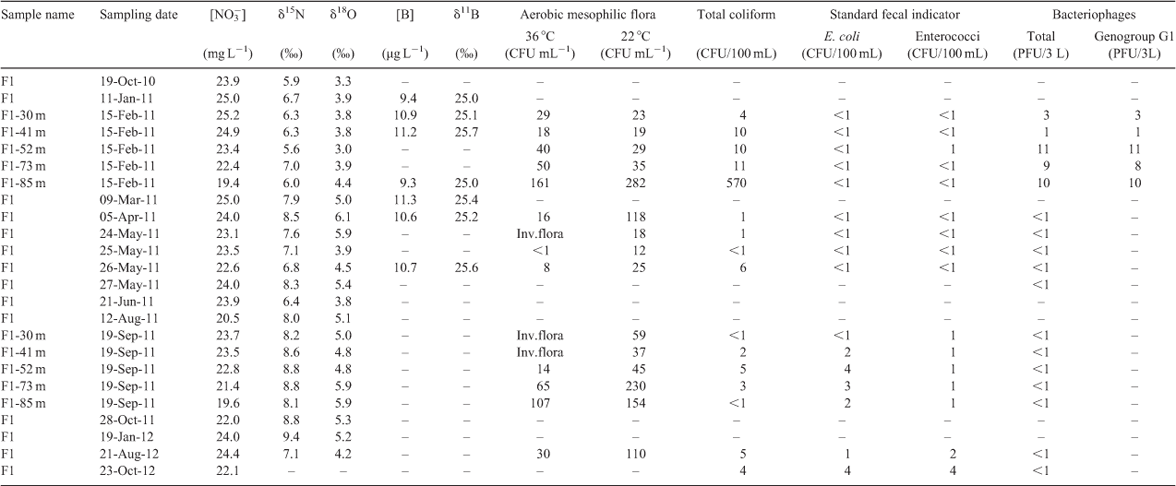Combination of nitrate (N, O) and boron isotopic ratios with microbiological indicators for the determination of nitrate sources in karstic groundwater
Cyrielle Briand A F , Valérie Plagnes A , Mathieu Sebilo B , Pascale Louvat C , Thierry Chesnot D , Maude Schneider D , Pierre Ribstein A and Pierre Marchet EA UPMC University of Paris 06, UMR Sisyphe, 4 place Jussieu, F-75252 Paris Cedex 05, France.
B UPMC University of Paris 06, UMR Bioemco, 4 place Jussieu, F-75252 Paris Cedex 05, France.
C Institut de Physique du Globe de Paris, Sorbonne Paris Cité, Université Paris-Diderot, UMR CNRS 7154, 1 rue Jussieu, F-75238 Paris Cedex, France.
D Eurofins Expertises Environnementales, Microbiologie, Santé-Environnement, rue Lucien Cuenot/site St Jacques II, F-54521 Maxeville, France.
E Agence de l’Eau Adour-Garonne, 90 rue du Férétra, F-31078 Toulouse Cedex 4, France.
F Corresponding author. Email: briandcyrielle@gmail.com
Environmental Chemistry 10(5) 365-369 https://doi.org/10.1071/EN13036
Submitted: 16 February 2013 Accepted: 3 August 2013 Published: 25 October 2013
Journal Compilation © CSIRO Publishing 2013 Open Access CC BY-NC-ND
Environmental context. Nitrate contamination of drinking water quality may be critical, particularly in rural areas where agricultural practices may release large amounts of nitrogen. Knowledge of the source of such contamination, mandatory for water supply management, can be successfully acquired by combining the natural stable isotopes of nitrate, boron isotopic ratios and microbiological indicators.
Abstract. A new approach based on measurements of nitrate and boron isotopic composition associated with microbiological indicators for the determination of nitrate origin in karstic groundwater (SW, France) is presented. Nitrate and boron isotopic data indicate an animal source of nitrate (δ15N–NO3– > 5 ‰, δ18O–NO3– < 10 ‰ and δ11B ~25 ‰). Microorganism detection (bacteriophages) confirmed contamination from animal sources and proved fast water transfer (2–3 days) from surface to groundwater.
Nitrate produced by anthropogenic activities is an important environmental issue, particularly in agricultural regions and especially when water is used as drinking water. Determination of the source of nitrate among the many potential sources is the first step towards water quality improvement.
Recent studies have proven the efficiency of the coupled use of nitrate (N and O) and boron isotope ratios to identify the origin of nitrate in water.[1–3] Nitrate from mineral fertilisers is characterised by atmospheric values of δ15N (~0 ‰) and δ18O (~23.5 ‰), whereas nitrate derived from organic fertilisers, livestock effluents and sewage is usually enriched in 15N (δ15N varies from +8 up to +20 ‰) because of ammonium volatilisation.[4–8] As animal and domestic waste δ15N overlap, additional tracers such as boron are used to discriminate between these two sources.[3]
Boron is a co-migrant of nitrate and a tracer of domestic water input to the environment.[9] Furthermore, it is not affected by processes affecting nitrate (e.g. denitrification).[3] Although fertiliser δ11B exhibits a wide range of values (–10 to 60 ‰), these ratios are significantly different from sewage (–2 to +2 ‰) and manure contaminations (5–50 ‰).[1–3,9]
In addition to this dual isotopic approach, we tested microbiological indicators (bacteriophages and Bacteroidales) to characterise the origin of faecal contamination occurring in groundwater.[10–14] F-specific RNA bacteriophages (FRNAPHs) are viruses, infecting bacteria of the gastrointestinal flora, with genogroups associated with animal (GI and GIV) or human (GII and GIII) faeces.[10–12,15] Bacteroidales is an order of Bacteria present in high numbers in the gastrointestinal tract of warm-blooded animals with host-specific distribution (humans, ruminants and pigs).[13,14,16] The use of microbiological markers allows a better discrimination among organic contaminants and gives complementary information on the transfer times within an aquifer (with a lifetime lasting a few days in the environment).
This new multidisciplinary approach was used to determine the origin of increasing nitrate concentrations in karstic groundwater located in an agricultural area. The borehole studied (F1) was dug up to 100 m deep in a Cretaceous limestone outcropping at the top of an anticline (Fig. 1). It is used for drink-ing water production for the South Aquitaine region (SW France), but nitrate concentrations have steadily increased from 5 mg L–1 in the 1970s to 25 mg L–1 since 2004 and traces of faecal contaminants have frequently been detected in the groundwater. The limestone aquifer is fed by deep groundwater but also by local recharge in the carbonate outcropping area (Fig. 1). The karstic nature of limestone potentially favours fast communication from surface to groundwater.

|
Water samples were regularly collected from this borehole from October 2010 to October 2012 at the pump outlet. Multilevel sampling was carried out twice (February and September 2011) using a mini pump within the borehole. All the samples were filtered through a 0.45-µm nylon membrane.
For nitrate concentrations, samples were stored frozen and were measured by high-performance liquid chromatography (HPLC Dionex, AS12 column). For the characterisation of the N and O isotopic composition of nitrate, samples were poisoned with HgCl2 and analysed after reduction to nitrite through a granular cadmium-filled column. Nitrite was then converted into nitrous oxide by adding azide.[17] The determination of δ15N and δ18O of N2O was performed through a purge-and-trap and continuous-flow isotope ratio mass spectrometry system (DeltaVplus Thermo coupled with Gas Bench II). The method was calibrated with nitrate standards (USGS-32, δ15N = 180 ‰, δ18O = 25.7 ‰; USGS-34, δ15N = 1.8 ‰, δ18O = 27.9 ‰ and USGS-35 δ15N = 2.7 ‰, δ18O = 57.5 ‰). The linearity of the analysis was checked with an internal nitrate standard (IAEA, δ15N = 4.7 ‰, δ18O = 25.6 ‰). The precision was 1.2 ‰ for δ15N and 1.3 ‰ for δ18O.
For boron analyses, samples were acidified to pH 2 with HNO3. Boron concentrations were determined by inductively coupled plasma optical–atomic emission spectroscopy (ICP OES/AES) JY2000. The 11B/10B isotopic ratios were measured by a multicollector inductively coupled plasma mass spectrometer (Neptune, ThermoScientific) using a direct-injection nebuliser (d-DIHEN, Analab).[18] Boron was first extracted from the samples using ion exchange chromatography. A volume of 5–30 mL of the samples at pH 9 was introduced into a column filled with 50 µL of resin (Amberlite IRA-743). Boron was retained on the resin and then eluted with dilute HNO3 (0.1 and 0.5 N).[18,19] δ11B values were calculated by bracketing sample measurements with NBS-951 boron standard measurements. The external reproducibility of δ11B measurements for natural water samples was 0.25 ‰ (2 s.d.).
For microbiological analyses, specific sampling bottles with sodium thiosulfates were used. Standardised methods were used to determine the concentration of total coliforms and Escherichia coli, Enterococcus species and total aerobic mesophilic flora.[20–22] FRNAPHs were enumerated by concentrating 3 L of a water sample using the membrane filtration–elution method.[23] Infectious FRNAPHs were counted (double agar-layer technique).[24] FRNAPHs contained in one plaque were collected, re-suspended in 1 mL of phosphate buffered saline (PBS) with 15 % glycerol and stored at –20 °C until genotyping, which was performed using a one-step real-time reverse-transcription polymerase chain reaction (RT-qPCR) kit (QuantiTech Probe RT–PCR, Qiagen) and previously described primers and probes.[11] To search for Bacteroidales, 2 L of sample water were filtered through a 0.22-µm pore size polycarbonate membrane. The filter was immersed in a guanidinium thiocyanate (GITC) lysis solution and stored at –80 °C until DNA extraction with a Qiamp DNA minikit (Qiagen). Previously described primers and probes were used to quantify ruminant (Rum-2-Bac),[14] pig (Pig-2)[13] and human (HF183)[16] Bacteroidales markers. Standard curves were calculated for plasmids containing the target sequence. The presence of PCR inhibitor factors was monitored by adding a known plasmid concentration to the sample. The results were expressed as several copies in 100 mL of water. PCR reactions were performed in duplicate for each sample with a Rotor gene 6000 thermocycler.
Nitrate concentrations measured in the borehole varied from 19.4 to 25.2 mg L–1. The lowest values (19.4 and 19.6 mg L–1) correspond to the deepest samples (85 m) from February and September 2011. This is consistent with the conceptual model of a double alimentation of the borehole: deep and slightly contaminated water and nitrate-contaminated surface water with a rapid infiltration rate.
The δ15N and δ18O ranges usually reported in the literature for the different potential sources of nitrate are presented in Fig. 2 with our isotopic data for the groundwater samples. Our δ15N and δ18O data fall within the organic boxes (sewage, manure or soil organic nitrogen-derived nitrate) with respective values of 5.6–9.4 and 3.0–6.1 ‰ (Table 1, Fig. 2).

|
Boron concentrations and isotopic compositions were measured for six samples, chosen to be representative of temporal and spatial variations. B concentrations varied only slightly, with an average value of 10.6 ± 0.7 µg L–1. The δ11B of these samples are rather homogeneous with an average value of 25.3 ± 0.3 ‰ (Table 1, Fig. 3). Combined δ15N and δ11B (Fig. 3) data correspond to values usually reported for nitrate originating from an animal source. It excludes nitrate derived from domestic effluents. This could be derived from manure spreading on maize fields or from localised livestock effluents.

|
The occurrence of the total viable count in the water of the F1 borehole ranged between <1 and 282 CFU mL–1 (colony-forming units per millilitre). Low coliform bacteria concentrations were observed in most water samples. However, standard faecal indicators (E. coli and Enterococcus) were detected in only three campaigns – September 2011, August 2012 and October 2012 – with concentrations under 4 CFU per 100 mL. FRNAPHs were detected in February 2011 at different depths of the F1 borehole with 3, 1, 11, 9 and 10 plaque forming units (PFU per 3 L) at respective 30-, 41-, 52-, 73- and 85-m depths. These concentrations are actually the same order of magnitude and cannot be considered significantly different for the five depths. Genotyping methods concluded that all these phages belong to genogroup I, which is generally associated with animal faecal pollution. Nevertheless, more extensive FRNAPH genotyping would be necessary to corroborate these preliminary results. Moreover, none of the host-specific Bacteroidales markers (human, porcine or ruminant) were detected, suggesting that another animal effluent could be responsible for faecal contamination occurring in the spring (duck and chicken farming are dominant in the studied area). Furthermore, the very short life span of microorganisms in groundwater (<2 days for bacteriophages)[25] proves that transfer from the surface to groundwater could be very fast, possibly favoured by karstic channels.
The determination of the origin of nitrate is an essential preliminary step for water resource management and remediation. In agricultural areas, where there can be multiple nitrate sources, the combination of nitrate and boron isotopic composition can be very helpful to differentiate the different sources. Moreover, in the case of faecal contamination, and when groundwater potentially receives direct infiltration from the surface, characterisation of microorganisms provides valuable information on the source of the contamination.
This new approach was applied here to the case of a karstic spring where nitrate concentrations have gradually increased over the last 40 years and where episodic faecal contaminations are measured.
The combined approaches indicate that borehole F1 water is contaminated with nitrate from animal effluents. The existence of rapid surface water transfer due to the karstic nature of the aquifer allows the detection of these specific microorganisms.
Acknowledgements
This work was supported by the Agence de l’Eau Adour-Garonne. The authors thank the Syndicat Intercommunal des Eaux du Marseillon for the technical assistance and the field knowledge they contributed.
References
[1] D. Widory, W. Kloppman, L. Chery, J. Bonnin, H. Rochdi, J. L. Guinamant, Nitrate in groundwater: an isotopic multi-tracer approach. J. Contam. Hydrol. 2004, 72, 165.| Nitrate in groundwater: an isotopic multi-tracer approach.Crossref | GoogleScholarGoogle Scholar | 1:CAS:528:DC%2BD2cXlsFeqtLw%3D&md5=2ed252f599713aa9aedc2d0dda53b656CAS | 15240171PubMed |
[2] R. L. Seiler, Combined use of 15N and 18O of nitrate and 11B to evaluate nitrate contamination in groundwater. Appl. Geochem. 2005, 20, 1626.
| Combined use of 15N and 18O of nitrate and 11B to evaluate nitrate contamination in groundwater.Crossref | GoogleScholarGoogle Scholar | 1:CAS:528:DC%2BD2MXosVajsL8%3D&md5=bfdc340c1b3317e757d04012fd293326CAS |
[3] J. Bronders, K. Tirez, N. Desmet, D. Widory, E. Petelet-Giraud, A. Bregnot, P. Boeckx, Use of compound-specific nitrogen (δ15N), oxygen (δ18O), and bulk boron (δ11B) isotope ratios to identify sources of nitrate-contaminated waters: a guideline to identify polluters. Environ. Forensics. 2012, 13, 32.
| Use of compound-specific nitrogen (δ15N), oxygen (δ18O), and bulk boron (δ11B) isotope ratios to identify sources of nitrate-contaminated waters: a guideline to identify polluters.Crossref | GoogleScholarGoogle Scholar | 1:CAS:528:DC%2BC38XktFWmtb4%3D&md5=7c56c9b3ce4138d26da37aca954f881cCAS |
[4] C. Kendall, Tracing nitrogen sources and cycling in catchment, in Isotope Tracers in Catchment Hydrology (Eds C. Kendall, J.J. McDonnell) 1998, pp. 519–576 (Elsevier: Amsterdam).
[5] S. V. Panno, K. C. Hackley, H. H. Hwang, W. R. Kelly, Determination of the sources of nitrate contamination in karts springs using isotopic and chemical indicators. Chem. Geol. 2001, 179, 113.
| Determination of the sources of nitrate contamination in karts springs using isotopic and chemical indicators.Crossref | GoogleScholarGoogle Scholar | 1:CAS:528:DC%2BD3MXltlGgtbk%3D&md5=e5d478d603b3bad78f1d9fad765a9cc5CAS |
[6] L. I. Wassenaar, M. J. Hendry, N. Harrington, Decadal geochemical and isotopic trends for nitrate in a transboundary aquifer and implications for agricultural beneficial management practices. Environ. Sci. Technol. 2006, 40, 4626.
| Decadal geochemical and isotopic trends for nitrate in a transboundary aquifer and implications for agricultural beneficial management practices.Crossref | GoogleScholarGoogle Scholar | 1:CAS:528:DC%2BD28XmsVSitrk%3D&md5=11766d04fc4499360b395b1f6ceeb2c0CAS | 16913116PubMed |
[7] F.-Z. J. El Gaouzi, M. Sebilo, P. Ribstein, V. Plagnes, P. Boeckx, D. Xue, S. Derenne, M. Zakeossian, Using δ15N and δ18O values to identify sources of nitrate in karstic springs in the Paris basin (France). Appl. Geochem. 2013, 35, 230.
| Using δ15N and δ18O values to identify sources of nitrate in karstic springs in the Paris basin (France).Crossref | GoogleScholarGoogle Scholar | 1:CAS:528:DC%2BC3sXoslWrs7w%3D&md5=5fec14bf7ee3d682d3f022e599e721b0CAS |
[8] S. L. Li, C. Q. Liu, J. Li, Z. Xue, J. Guan, Y. Lang, H. Ding, L. Li, Evaluation of nitrate source in surface water of southwestern China based on stable isotopes. Environ. Earth Sci. 2013, 68, 219.
| Evaluation of nitrate source in surface water of southwestern China based on stable isotopes.Crossref | GoogleScholarGoogle Scholar | 1:CAS:528:DC%2BC3sXhsFCltA%3D%3D&md5=d57bfe210cb76161137ba1658b59848aCAS |
[9] B. Chetelat, J. Gaillardet, Boron isotopes in the Seine River, France: a probe of anthropogenic contamination. Environ. Sci. Technol. 2005, 39, 2486.
| Boron isotopes in the Seine River, France: a probe of anthropogenic contamination.Crossref | GoogleScholarGoogle Scholar | 1:CAS:528:DC%2BD2MXitVCks7g%3D&md5=cac77a0c9a51d8fdb87ff9bc564642a5CAS | 15884339PubMed |
[10] M. Schaper, J. Jofre, M. Uys, W. O. K. Grabow, Distribution of genotypes of F-specific RNA bacteriophages in human and non-human sources of faecal pollution in South Africa and Spain. J. Appl. Microbiol. 2002, 92, 657.
| Distribution of genotypes of F-specific RNA bacteriophages in human and non-human sources of faecal pollution in South Africa and Spain.Crossref | GoogleScholarGoogle Scholar | 1:CAS:528:DC%2BD38XjvVKiurY%3D&md5=cfe222a38042306faa1411eb30ebe6cbCAS | 11966906PubMed |
[11] L. Ogorzaly, C. Gantzer, Development of real-time RT-PCR methods for specific detection of F-specific RNA bacteriophage genogroups: application to urban raw wastewater. J. Virol. Methods 2006, 138, 131.
| Development of real-time RT-PCR methods for specific detection of F-specific RNA bacteriophage genogroups: application to urban raw wastewater.Crossref | GoogleScholarGoogle Scholar | 1:CAS:528:DC%2BD28XhtFeqtLnP&md5=43ec91200571505527ff95b38bbbcd67CAS | 16997389PubMed |
[12] A. R. Blanch, L. Belanche-Muñoz, X. Bonjoch, J. Ebdon, C. Gantzer, F. Lucena, J. Ottoson, C. Kourtis, A. Iversen, I. Kühn, L. Mocé, M. Muniesa, J. Schwartzbrod, S. Skraber, G. T. Papageorgiou, H. Taylor, J. Wallis, J. Jofre, Integrated analysis of established and novel microbial and chemical methods for microbial source tracking. Appl. Environ. Microbiol. 2006, 72, 5915.
| Integrated analysis of established and novel microbial and chemical methods for microbial source tracking.Crossref | GoogleScholarGoogle Scholar | 1:CAS:528:DC%2BD28XpvVKjsb8%3D&md5=982f89bbee79a33eb35b188315ea4914CAS | 16957211PubMed |
[13] S. Mieszkin, J. P. Furet, G. Corthier, M. Gourmelon, Estimation of pig fecal contamination in a river catchment by Real-Time PCR using two pig-specific bacteroidales 16S rRNA genetic markers. Appl. Environ. Microbiol. 2009, 75, 3045.
| Estimation of pig fecal contamination in a river catchment by Real-Time PCR using two pig-specific bacteroidales 16S rRNA genetic markers.Crossref | GoogleScholarGoogle Scholar | 1:CAS:528:DC%2BD1MXmsFWis7s%3D&md5=73fac569cd058541ec6953b082855d41CAS | 19329663PubMed |
[14] S. Mieszkin, J. F. Yala, R. Joubrel, M. Gourmelon, Phylogenetic analysis of bacteroidales 16S rRNA gene sequences from human and animal effluents and assessment of ruminant faecal pollution by real-time PCR. J. Appl. Microbiol. 2010, 108, 974.
| Phylogenetic analysis of bacteroidales 16S rRNA gene sequences from human and animal effluents and assessment of ruminant faecal pollution by real-time PCR.Crossref | GoogleScholarGoogle Scholar | 1:CAS:528:DC%2BC3cXktVOnsb0%3D&md5=af599e2ba18fe8719dfdf0778b2ab4ceCAS | 19735325PubMed |
[15] F. C. Hsu, Y. S. Shieh, J. Duin, M. J. Beekwilder, M. D. Sobsey, Genotyping male-specific RNA coliphages by hybridization with oligonucleotide probes. Appl. Environ. Microbiol. 1995, 61, 3960.
| 1:CAS:528:DyaK2MXptFGgt7c%3D&md5=a61d2269ca634fa21aeee85d76d9a4aeCAS | 8526509PubMed |
[16] S. Seurinck, T. Defoirdt, W. Verstraete, W. S. D. Siciliano, Detection and quantification of the human-specific HF183 bacteroides 16S rRNA genetic marker with real-time PCR for assessment of human faecal pollution in freshwater. Environ. Microbiol. 2005, 7, 249.
| Detection and quantification of the human-specific HF183 bacteroides 16S rRNA genetic marker with real-time PCR for assessment of human faecal pollution in freshwater.Crossref | GoogleScholarGoogle Scholar | 1:CAS:528:DC%2BD2MXhslSlt7Y%3D&md5=78de41b89fc5ed8ef484bed1e3b1741eCAS | 15658992PubMed |
[17] P. Semaoune, M. Sebilo, J. Templier, S. Derenne, Is there any isotopic fractionation of nitrate associated with diffusion and advection? Environ. Chem. 2012, 9, 158.
| Is there any isotopic fractionation of nitrate associated with diffusion and advection?Crossref | GoogleScholarGoogle Scholar | 1:CAS:528:DC%2BC38XmsFGnt74%3D&md5=12824245a51c0b17705c8ac06b0dcab8CAS |
[18] P. Louvat, J. Bouchez, G. Paris, MC-ICP-MS isotope measurements with direct injection nebulisation (d-DIHEN): optimisation and application to boron in seawater and carbonate samples. Geostand. and Geoanal. Res. 2011, 35, 75.
| MC-ICP-MS isotope measurements with direct injection nebulisation (d-DIHEN): optimisation and application to boron in seawater and carbonate samples.Crossref | GoogleScholarGoogle Scholar | 1:CAS:528:DC%2BC3MXkvVaqsLk%3D&md5=a3bfe2f556740cf700eca3718914478aCAS |
[19] D. Lemarchand, J. Gaillardet, C. Göpel, G. Manhès, An optimized procedure for boron separation and mass spectrometry analysis for river samples. Chem. Geol. 2002, 182, 323.
| An optimized procedure for boron separation and mass spectrometry analysis for river samples.Crossref | GoogleScholarGoogle Scholar | 1:CAS:528:DC%2BD38XhtlSltbw%3D&md5=5601ec6b05ab3a01060e3334f482cff1CAS |
[20] ISO 9308-1. Water quality - detection and enumeration of Escherichia coli and coliform bacteria. Part 1. Membrane filtration method 2000 (International Organization for Standardization: Geneva, Switzerland).
[21] ISO 7899-2. Water quality – detection and enumeration of intestinal enterococci. Part 2. Membrane filtration method 2000 (International Organization for Standardization: Geneva, Switzerland).
[22] ISO 6222. Water quality – enumeration of culturable micro-organisms – colony count by inoculation in a nutrient agar culture medium 1999 (International Organization for Standardization: Geneva, Switzerland).
[23] J. Méndez, A. Audicana, A. Isern, J. Llaneza, B. Moreno, M. L. Tarancon, J. Jofre, F. Lucena, Standardised evaluation of the performance of a simple membrane filtration-elution method to concentrate bacteriophages from drinking water. J. Virol. Methods 2004, 117, 19.
| Standardised evaluation of the performance of a simple membrane filtration-elution method to concentrate bacteriophages from drinking water.Crossref | GoogleScholarGoogle Scholar | 15019256PubMed |
[24] ISO 10705-1. Water quality – detection and enumeration of bacteriophages. Part 1. Enumeration of F-specific RNA bacteriophages 2001 (International Organization for Standardization: Geneva, Switzerland).
[25] L. Ogorzaly, I. Bertrand, M. Paris, A. Maul, C. Gantzer, Occurrence, survival, and persistence of human adenoviruses and F-Specific RNA phages in raw groundwater. Appl. Environ. Microbiol. 2010, 76, 8019.
| Occurrence, survival, and persistence of human adenoviruses and F-Specific RNA phages in raw groundwater.Crossref | GoogleScholarGoogle Scholar | 1:CAS:528:DC%2BC3MXhtFGksL8%3D&md5=082bc7642b0d162bcd5cddabb610a460CAS | 20952644PubMed |



